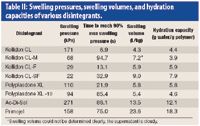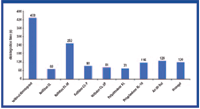A Comparative Study of Current Superdisintegrants
Evaluating disintegrant properties and consistency in performance is an essential part of tablet formulation.
Despite a rising interest in controlled-release drug delivery systems, the most common tablets are those intended to be swallowed whole, disintegrating and releasing their medicaments rapidly in the gastrointestinal tract. A disintegrant is a substance in a tablet formulation that enables the tablet to break up into smaller fragments upon contact with gastrointestinal fluids. Such a rapid rupture of the tablet matrix increases the surface area of the tablet particles, thereby increasing the rate of absorption of the active ingredient and producing the desired therapeutic action (1).

The proper choice of disintegrant and its consistency of performance are critical to formulation development of such tablets. In the past, starch was one of the most widely used, inexpensive, and effective tablet disintegrants. A high concentration of starch is required to bring about effective disintegration. Scientists' search for disintegrating agents with efficient disintegrating properties at relatively low concentrations has led to the development of some new compounds with excellent disintegrating properties.
Superdisintegrants generally are used at a low level in the solid dosage form, typically 1–10% by weight relative to the total weight of the dosage unit. Examples of superdisintegrants are crosscarmelose, crospovidone, and sodium starch glycolate, which are a crosslinked cellulose, crosslinked polymer, and a crosslinked starch, respectively. BASF is one manufacturer of crospovidone under the trade name of insoluble "Kollidon" grades. Another manufacturer is ISP's "Polyplasdone XL" grade. Crosscarmelose is marketed mainly as the brand name of "Ac-Di-Sol" by FMC BioPolymer and sodium starch glycolate as "Primojel" from DMV International.
Insoluble grades of Kollidon (crospovidone) are manufactured by a polymerization process that yields crosslinked insoluble polyvinyl-pyrrolidone in the form of a "popcorn" polymer. The polymerization is performed using an aqueous system. No organic solvents are involved at any stage. The crosslinking is of chemical and physical nature, which is mainly achieved by the entanglement of the polymer chains and dominates the product's properties.
Unlike povidone, crospovidone is completely insoluble in solvents and the corresponding products cannot be named according to a K-value or a molecular weight. The product differentiation is conducted mainly by the particle-size distribution. The bulk density and swelling behavior also play an important role in disintegration behavior (2). (BASF supplies the following insoluble grades of Kollidon: Kollidon CL, Kollidon CL-F, Kollidon CL-SF, and Kollidon CL-M, which all comply with current monographs in the European, Japanese, and US pharmacopeias.)
Physical characteristics
Insoluble Kollidon grades are supplied as fine, white, and almost-white powders. They have a slight characteristic odor and are practically tasteless. They are insoluble in all usual solvents.
Bulk and tapped densities of Polyplasdone XL are lower than those of Kollidon CL, perhaps because of the porous structure of Polyplasdone XL or the smoother surface area of Kollidon CL. In consequence of the smaller particle size, bulk densities of Kollidon CL-F and Kollidon CL-SF are lower than the bulk density of Polyplasdone XL grades. Because of its smooth particle surface, Primojel had the highest bulk and tapped densities of all disintegrants. The density of Ac-Di-Sol is between those of Kollidon CL and Primojel (3) (see Table I).

Table I: Characteristics of various disintegrants.
The average particle sizes of Kollidon CL-F and Kollidon CL-SF are significantly lower than those of Kollidon CL and Polyplasdone XL. Kollidon CL-M has the lowest particle size. Polyplasdone XL-10 exhibits a similar particle size as Kollidon CL-F. Ac-Di-Sol and Primojel are significantly finer than Kollidon CL and Polyplasdone XL but coarser than the other disintegrants (Particle size was measured on a "Mastersizer," Malvern Instruments) (3) (see Table I).
One of the most important properties of the insoluble Kollidon-CL grades used as tablet disintegrants are their property to swell very fast and predictably without forming a gel. Several methods are described in the literature for measuring swelling properties in aqueous media. The swelling pressure was measured with a powder mass of 0.3 g and a punch diameter of 25 mm (see Table II)

Table II: Swelling pressures, swelling volumes, and hydration capacities of various disintegrants.
The swelling pressure depends on the rate and extent of uptake of water as well as the porosity of the polymer, which can be dictated by the basic nature of the polymer chain, degree of crosslinking, and type of crosslinkage. Ac-Di-Sol shows the highest swelling pressure, followed by Kollidon CL and Primojel. Kollidon CL had the quickest increase of swelling pressure, which may contribute to the superdisintegration properties of this material. In general, crosslinked polyvinyl-pyrrolidone (PVP) grades show a limited swelling behavior to a certain particle volume, whereas Ac-Di-Sol and Primojel have more or less unlimited swelling and form a gel. It is also noteworthy that neither swelling pressure nor volume expansion alone can explain the disintegration efficacy of excipients (3).
Swelling of disintegrant particles is perhaps the most widely accepted mechanism for tablet disintegration, primarily because almost all disintegrants swell to some extent. To determine swelling volume in water, 10 g of polymers were weighed into a 100-mL graduated cylinder. The graduated cylinder was filled with water, closed, and shaken very well. The sediment volume was determined after 24 h.
Polyplasdone XL and XL-10 showed higher swelling volumes than Kollidon CL. Kollidon CL-F has similar swelling volume to Polyplasdone. Furthermore, it is noticeable that Kollidon CL-SF exceeds all other cross-linked PVPs. Ac-Di-Sol and Primojel have the highest swelling volume.
Crosslinked PVP has been reported as a better disintegrant than either starch or alginic acid, attributed to the substance's capacity to absorb more than 50% of its own weight in water. Because of its low bulk density (0.26 g/mL), it tends to distribute evenly in the tablet matrix, thereby increasing surface area and the number of sites for capillary action (4).
To determine the hydration capacity, 2 g of polymer were weighed into a centrifuge vessel with 40 mL of water. The polymer swelled for 15 min, and the suspension was centrifuged at 2000 rpm for 15 min. The supernatant was poured off, and the residual weight was determined. The hydration capacity of Polyplasdone XL was higher than those of Kollidon CL and Polyplasdone XL-10, but comparable with Kollidon CL-F. Kollidon CL-SF had the highest hydration capacity of all crosslinked PVP (see Table II).
Applications
Crospovidone is one of the three superdisintegrants described in the literature. The mechanism of action is a capillary action with a secondary swelling effect. The improvement of tablet disintegration also has been observed through predictable swelling without gel formation. Crospovidone is a disintegrating agent at the 2–5% level and is an effective binder–disintegrant in tablets prepared using wet granulation. Furthermore, swelling properties paired with particle-size distribution make the finer grades of crospovidone work efficiently in fast-disintegrating formulations. The following formulations were tested to determine the disintegration properties:
Formulation 1. Formulation 1 consisted of 467.50 mg "Ludipress LCE" (BASF), 30.00 mg disintegrant, and 2.50 mg magnesium stearate. The tablet weight was 500.00 mg. Ludipress LCE is a combination of lactose monohydrate and povidone. All the ingredients were weighed, sieved (0.8 mm), mixed for 10 min, and compressed into tablets.

Figure 1: Disintegration time of various disintegrants (Formulation 1).
Formulation 2. Formulation 2 comprised 250.00 mg AAS-powder, 250.00 mg paracetamol crystals, 0.2–0.5 50.00 mg caffeine granules, 27.50 mg povidone K30, 16.00 mg disintegrant, and 5.00 mg magnesium stearate. The tablet weight was 598.50 mg. The formulation was performed using wet granulation. The active ingredients and povidone were initially granulated with water. To dry, the granules were spread on a tray, stored for two days at ambient conditions, and sieved again in a horizontal sieve (Alexanderwerk).

Figure 2: Disintegration time of various disintegrants (Formulation 2).
Conclusion
The study compared various superdisintegrants in terms of physicochemical properties and use in direct compression and compression after wet granulation. Polyplasdone XL and Kollidon CL displayed obvious differences in various parameters. The particle-size distribution of Polyplasdone XL is broader, and the swelling volume is bigger than those of Kollidon CL. Kollidon CL-F and SF grades had a substantially smaller particle size than Kollidon CL and Polyplasdone XL and showed higher swelling volumes and hydration capacities.
In contrast to crospovidone, Ac-Di-Sol and Primojel generate a gel-like consistency upon contact with water, causing high swelling volume and medium-to-high swelling pressure. The disintegration effect should be correlated with particle size. This study indicated that a combination of various properties, including swelling pressure and volume, hydration capacity, and swelling behavior create a good disintegrant.
Anisul Quadir, PhD, MBA,* is a technical manager for Pharma Solutions at BASF Corporation, 1705 Route 46 W, Ledgewood, NJ 07852, tel. 973.448.5313, fax 973.448.5334, Anisul.Quadir@basf.comKarl Kolter, PhD, is a manager of research and development for Pharma Solutions at BASF AG, Ludwigshafen, Germany.
*To whom all correspondence should be addressed.
References
1. R. Shangraw, A. Mitrevej, and M. Shah, "A New Era of Tablet Disintegrants," Pharm. Technol. 4 (10), 48–57 (1980).
2. Insoluble Kollidon Grades, BASF Technical Bulletin, p. 4, 2006.
3. Unpublished BASF internal report.
4. R. Shangraw, J. Wallace, and F. Bowers, "Morphology and Functionality in Tablet Excipients for Direct Compression," Pharm. Technol. 5 (10), 44–60 (1981).
Drug Solutions Podcast: A Closer Look at mRNA in Oncology and Vaccines
April 30th 2024In this episode fo the Drug Solutions Podcast, etherna’s vice-president of Technology and Innovation, Stefaan De Koker, discusses the merits and challenges of using mRNA as the foundation for therapeutics in oncology as well as for vaccines.
Drug Solutions Podcast: Applying Appropriate Analytics to Drug Development
March 26th 2024In this episode of the Drug Solutions Podcast, Jan Bekker, Vice President of Business Development, Commercial and Technical Operations at BioCina, discusses the latest analytical tools and their applications in the drug development market.
